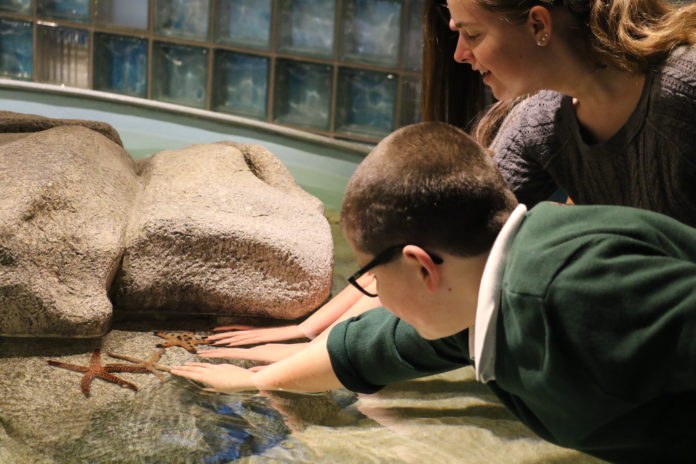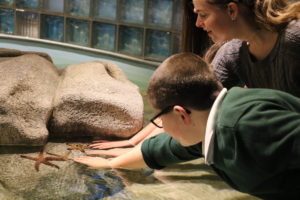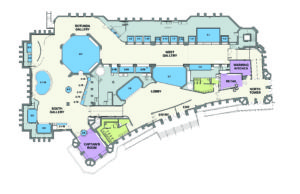
It takes a county to raise an aquarium.

The Toledo Zoo’s $25.5 million aquarium renovation is almost complete, two and a half years after closing for the project. The aquarium will be unveiled March 27 at the beginning of a weekend full of events dedicated to the 178,000 gallons of water containing more than 3,000 animals.
“The Lucas County public loves that aquarium,” said Jeff Sailer, the zoo’s executive director. “They loved their old aquarium and I think they’re going to love their new aquarium. It’s beautiful inside and there’s a lot more interactivity that guests can be involved in. There are a lot of exhibits that allow hands-on experience. It’s a really cool space.”
The public has a large stake in the aquarium — 80 percent of the total cost for the project comes from the zoo’s 2006 capital improvement levy approved by Lucas County voters. The remaining 20 percent came from private donors.
Aquarium-wise, it doesn’t get much more interactive than touching a shark. Visitors will get up-close opportunities at the new aquarium, as well as chances to interact with rays, sea stars and other animals of the ocean.
“None of this could have happened without Lucas County voter support,” Sailer said. “We are very, very grateful to have the support we have from the local community. We couldn’t offer these great exhibits otherwise.”
The numbers tell the story of progress. In October 2012, when the aquarium closed for the renovation, it contained 46,000 gallons. Today it holds 178,000. The largest exhibit, the reef tank (supported by Owens-Illinois) holds 90,000 gallons of water, or nearly twice the old aquarium’s total capacity. Formerly, the largest exhibit was 7,600 gallons. The building’s exhibits were previously 37 percent saltwater; that number is now 87 percent.
Despite the massive jump in tank capacity, the building’s “footprint” taking up about 30,000 square feet remains the same.
The 1939 building was a Works Progress Administration (WPA) building. The WPA was one of President Franklin D. Roosevelt’s New Deal agencies, employing millions of unemployed Americans to build public buildings. The building was crafted from river shale, salvaged clay brick and lumber, cement and new glass block. The foundation materials were selected to support the massive weight of thousands of gallons of water.
At the time, it was the world’s largest freshwater aquarium. Over time, as interest in marine species and the oceans grew, saltwater exhibits were added. The corrosive saltwater was not friendly to piping and other systems in the aquarium.
“Eighty-some years from opening, the saltwater did a real number on the tanks and infrastructure of the building,” Sailer said.
However, the building itself remained in excellent condition.
“Basically, we kept the outside the same,” Sailer said. “The only thing that’s changed is the entrance, which has been relocated back to its original location at the center of the building.”
Creative use of existing space, coupled with more efficient, less bulky life-support systems, allowed for the significantly larger tank capacity.
For Sailer, who came to the Toledo Zoo from New York City’s zoo system just months before the aquarium renovation began, the transformation was a thing to behold.
“It was really interesting because I was only able to see it a couple of times before we closed it in 2012,” he said. “I never would have guessed that we had all this space there that we did.”

The largest exhibit, the 90,000-gallon reef tank, is located in what was originally the rotunda, where the old shark model was hanging from the ceiling.
“Now, the rotunda itself, that round room, is the tank and you’re on the outside of it looking in,” Sailer said.
The 30-by-16-foot tank contains sharks and colorful tropical Pacific reef fishes, and offers opportunities for visitors to communicate with an aquarium keeper and trained volunteer divers through an underwater microphone.
The second largest tank will be the Gulf of Mexico exhibit, featuring black nose and bonnethead sharks, rays and a sea turtle, which is part of a conservation education program to assist in the protection of wild turtles.
Other highlights include exhibits dedicated to South America’s Amazon ecosystem, the zoo’s new electric eel, deep-sea creatures such as giant Japanese spider crabs and aquatic life from the Lake Erie islands and Ohio waterways.
The grand opening weekend, sponsored by Kroger, is the culmination of work initiated well in advance of the aquarium’s closing, Sailer said.
“People think of it as being a two-and-a-half year project,” he said. “It’s been in the works for over six years with the design, planning all of the infrastructure and what the interior would look like.
“I’m really excited. I can’t wait to be here opening weekend and see people’s reaction to it. I’m floored by how beautiful it is and I’ve gotten to see it as it’s been developed and built. I’m really excited to show it off to others.”
The renovation was not the first time the aquarium closed.
On Thanksgiving 1982, fire tore through the roof, killing 104 display fish and 500 feeder fish. Among the fish lost were arapaima and a pacu which was among the largest of its species in the U.S. The aquarium was closed for three months for repairs.
On April 13, 1987, an inch-thick glass tank panel split open, sending 20 tons of water onto the aquarium’s floor. Zoo employees were able to save two lemon sharks by placing them in a secondary saltwater tank in the basement, but many smaller fish were lost.
Sailer said the economic impact of the renovation was significant, as 27 prime contractors and nine prime consultants were utilized in the project, resulting in 114,600 hours of on-site labor (not including work by zoo staff). Despite the unique and specialized nature of aquarium design and expertise, more than 50 percent of the architecture and engineering team used is from within 30 miles of the zoo.
The addition of the modern aquarium only adds to the value of the zoo to the community, Sailer said.
“We’re able to offer both a world-class zoo and an aquarium for one low price,” he said. “A lot of stand-alone aquariums are over $20 for a ticket.”
Zoo tickets are $17 for adults and $14 for children 2-11 years old.
In a September 2012 news release, Sailer said, “We realize 2015 seems far away, but we’re confident that, once you see the new aquarium, you’ll agree it was worth the wait.”
Time to find out, Lucas County.
For more information, visit www.toledozoo.org.






















